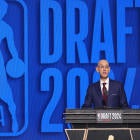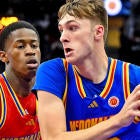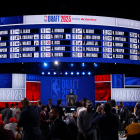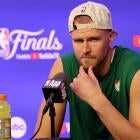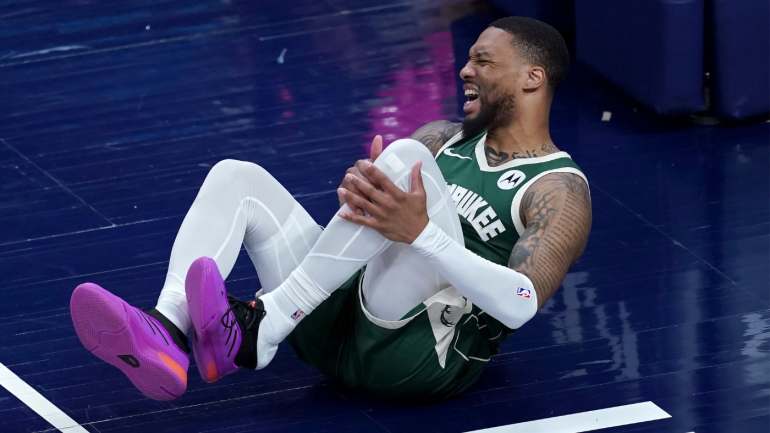
The NBA wants star players on the court as much as possible. If that wasn't already self-evident, the league made it clear that this was a priority when it instituted a stricter Player Participation Policy (PPP) last September, which followed the introduction of a 65-game minimum for end-of-season eligibility in the new collective bargaining agreement.
It is fair, then, to wonder why, during the 2024 playoffs, star players have been dropping faster than diss tracks. (Zion Williamson, Jimmy Butler, Kawhi Leonard, Damian Lillard, Kristaps Porzingis, OG Anunoby, Mitchell Robinson, Donovan Mitchell and Tyrese Haliburton are among the notable names who have missed games after getting hurt in these playoffs.) During his two-and-a-half hour end-of-season press conference on Tuesday, Oklahoma City Thunder executive vice president and general manager Sam Presti noted that, in addition to the PPP and the 65-game rule, there were other changes this season: The first annual In-Season Tournament, now named the NBA Cup, resulted in a compressed schedule during the second half of the season, and officials called a historically low amount of fouls after the All-Star break. One does not need to be a sports scientist to understand how a more tightly packed late-season schedule, combined with increased physicality, might lead to more injuries leading up to and during the postseason.
"If these things are not working in concert, I think we just gotta keep an eye on it," Presti told reporters.
Presti said that he's been a "big proponent" of the tournament and described commissioner Adam Silver as "a miraculous visionary for the business." He also said that "the outcome we want" is to get "the best players on the court as much as possible and in a position to perform at their best."
In Presti's view, the league needs to look at how the various things they've implemented are "colliding with each other." So let's look at each of them.
The 65-game rule and the PPP
Presti said he was "very supportive" of the idea that players need to be as available as possible. "There probably did need to be some correction on that, there's no question about that," he said. He also noted that stars played in 84% of their games in the first half of the season, which appeared to be a "huge win, but they're also incentivized to play in those games because you gotta get to 65 to get your money, to get your recognition. So it's a bit of a carrot system."
If stars had continued to play in more games than they have in recent years, then the rule changes would look like unequivocal success stories. But that's not what happened.
"After the All-Star break, that number dropped to 72%, which is one of the lowest numbers we've seen, I think, in the last 10 years," Presti said. "Then we get to the playoffs, and the stars are playing in 85% of the games. That's the second-lowest in the last 10 years."
In January, the NBA sent teams and media a 57-page report about load management, its primary finding being that it could not conclude that resting players leads to fewer injuries. It did not conclude that resting players doesn't help reduce injuries, either, though, and, crucially, neither Silver nor Joe Dumars, the league's vice president of basketball operations, has ever denied that resting players can improve performance.
"We're not a big load-managing team, but I also think it's a straw man argument to say that load management is about injury prevention," Presti said. "It's really [more] about performance -- maximizing performance -- than it is injury prevention. So I think that's kind of a false argument on that."
The NBA Cup and the compressed schedule
In discussing the new rules, Dumars has repeatedly said that the NBA is "an 82-game league." These 82 games, however, are not distributed evenly, and the tournament made scheduling much more complicated. When the league released its schedule last summer, each team had 80 games on it, rather than the full 82, and there were zero games scheduled from Dec. 3 to Dec. 10. Games were added on most of those days, but the schedule remained empty on Dec. 3 and Dec. 10 and there were no non-tournament games on Dec. 7 (the day of the semifinals) or Dec. 9 (the day of the championship game).
The second half of the season "was more compressed and had more back-to-backs, less days off, than any non-COVID schedule since like 2015-16," Presti said. "So you've got players playing more [early on], for incentive, but in the back half of the schedule, I mean, every team had a schedule like this, but we had 17 games in a month, we had five back-to-backs in that month, because there's just no room in the schedule."
Presti pointed out that the league now takes the night off on Election Day, and that its All-Star break is longer than ever. These are good things, as is the NBA Cup, but if they are not accompanied by a reduction in the overall number of games or an increase in the length of the season, then there will be consequences.
"Those games gotta go somewhere, Presti said.
Presti said that "the medical arm of the NBA office" -- he specifically mentioned David Weiss, the league's senior vice president of player matters, and Dr. John DiFiori, the league's director of sports medicine -- should have "final approval on the schedule." His idea, essentially, is for these experts to have to stamp each team's schedule as sufficiently protective of player health and wellness.
"I just think getting them involved in the schedule would be a huge win, and I think would take some of the bemoaning and criticism from the teams away if you already had the medical folks say, 'Yeah, this is suitable for NBA athletes,'" Presti said. "I just think it would be extremely innovative to do that, and we're the most innovative league, so why are we holding back from getting them more involved in being a part of the scheduling?"
The officiating changes
On April 9, the Boston Celtics attempted zero free throws in an NBA basketball game, the first time it had ever happened. Their opponents, the Milwaukee Bucks, attempted two free throws. The next day, in a press conference coinciding with the Board of Governors meetings, Silver called this "an anomaly," but acknowledged that there was a decrease of "roughly two team fouls per game" as the season went on.
"I think there was a sense earlier in the season that there was too much of an advantage for the offensive players, whether -- I think [Golden State Warriors coach] Steve Kerr said offensive players were using themselves as projectiles or hunting for fouls, however you want to call it," Silver said. "So that was a point of emphasis on behalf of the league. We were transparent with our teams about that. Again, everyone can see what's happening on the floor and make their own judgments about the calls being made. So, yes, there was a bit of an adjustment made along the way."
The phrase "a bit of an adjustment" is a bit of an understatement. It appeared that, overnight, much more physical contact was allowed.
"Whether we say that we changed the rules or we changed the way the rules were being enforced, there was a significant change," Presti said. "There was a bigger drop-off in fouls called than we've ever seen in the history of the league, so it wasn't a [small] modification. Right? It was a change. And that's fine. That's the rules of the game, that's what happened. But we went from 22.6 free throws a game per team to 19.8 after the break. That's three a game. Again that's the biggest drop in free throws in the second half of the season as far back as you can go data-wise."
For context, Presti noted that 19.8 free throws per game would be the lowest league-wide average in history, and that the average team shot 26.5 free throws per game in the 1990s, which was, in Presti's words, the age of "brawl-ball."
Presti said he doesn't have a problem with increased physicality, per se, but he thinks that "we need to watch those three components" -- i.e. the anti-rest policies, the schedule and the officiating -- "and the availability in the playoffs for the best players."
In his view, it has gotten to the point where referees are "managing the physicality" rather than "calling the games, technically calling the fouls." He didn't mention the Bucks-Celtics game specifically, but it's safe to assume he wasn't thrilled about it.
"I don't think the goal is to get free throws out of the game because free throws are part of basketball," Presti said. "We had some games this year where there were no free throws. That's not a basketball game. You get free throws in a basketball game."
'I just want to protect the players'
Presti repeatedly stressed that he just wanted to "flag" these issues. He did not rip Silver or the NBA, but he made it clear that he didn't want the league to go from one end of the spectrum to the other when it comes to player health and wellness.
"I just want to protect the players," he said. "I think that's the main thing."
Whenever the league makes a major change, there will be unintended consequences, some more serious than others. And while it seems that the NBA Cup, like the Play-In, did what it was supposed to in terms of adding stakes to early season games, Presti isn't the only one wondering whether it might have come at a cost. Earlier this week, in his end-of-season press conference, Cleveland Cavaliers president Koby Altman said that his team -- and the rest of the league -- had to study how to best handle a season that is this long and includes this many high-stakes games.
"Zooming out and looking at the league as a whole, I've never seen a playoffs like this where we've seen this many stars out," Altman said. "That was not specific to just the Cavs. And so I think just looking at the landscape of the long season and what it entails now, I think it's a really good question: How do we solve this player-injury piece?
"I think we have more meaningful games now during the regular season than we've ever had. And so we've added the In-Season Tournament, now the NBA Cup, that has I think five games of group play. That intensity gets risen, right? Those are playoff-level-intensity games that are at the beginning of the season. The Play-In Tournament at the end of the season, which we thought was going to elevate sort of the teams at the bottom to try to make it at the end and make a run at it — the unintended consequence is the top six teams don't want to lose and drop out of it, and so for the last six weeks of the season, you see a huge ramp-up in load and in playing in meaningful games."
Altman then said that the PPP "puts another burden on this usage."
To critics of the PPP and the 65-game rule, such policies rest on a faulty assumption that star players were missing games to avoid playing basketball rather than to avoid injury, as The Ringer's Danny Chau put it. The truth is that, generally speaking, players want to play, often even when they shouldn't. Less than two weeks ago, New York Knicks forward OG Anunoby, who had strained his hamstring in Game 2 of their second-round series against the Indiana Pacers, told coach Tom Thibodeau that he wanted to play in Game 7. The medical staff cleared him to give it a go, but after watching Anunoby amble around for a few minutes, Thibodeau pulled him, saying later that he "didn't want to risk it."
Sometimes, when a player won't say his body has been pushed to its limit, his body will say it for him. Throughout the playoffs, all the sidelined stars have spoken volumes.












